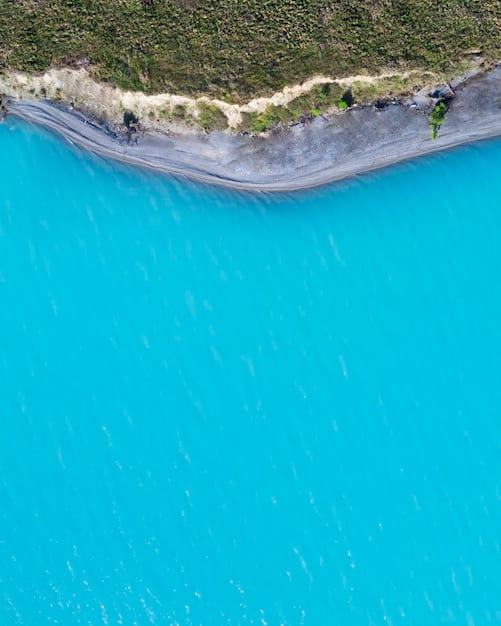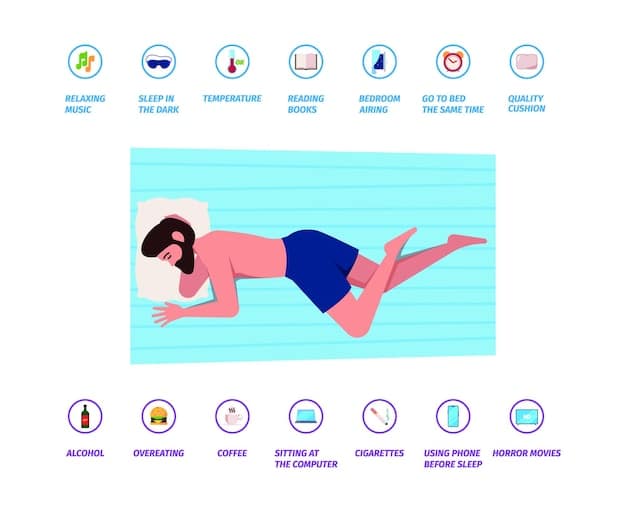Stay Safe from Rip Currents: Visual Guide to US Beaches 2025

Navigating US beaches safely in 2025 requires vigilance against rip currents, powerful channels of water moving away from the shore, which necessitate understanding visual cues and proactive safety measures to prevent drownings and ensure enjoyable coastal experiences.
As millions flock to the picturesque shores of the United States each year, the allure of the ocean is undeniable. However, beneath the inviting surface lies a potential hazard often underestimated: rip currents. While seemingly innocuous, these powerful channels of water can quickly pull even experienced swimmers away from the safety of the shore. Our definitive guide, “Understanding Rip Currents: A Visual Guide to Staying Safe at US Beaches in 2025,” aims to equip you with the essential knowledge and visual cues necessary to identify, avoid, and escape rip currents, ensuring your beach visits remain safe and enjoyable for years to come.
Understanding the Dynamics of Rip Currents
Rip currents are naturally occurring phenomena along coastlines worldwide, including the vast and varied beaches of the US. They are essentially narrow, fast-moving channels of water that flow away from the shoreline, often appearing deceptively calm or even as breaks in the incoming wave pattern. Their power lies in their ability to rapidly drag swimmers offshore, creating a sense of panic and exhaustion.
Originating from breaks in sandbars or near structures like jetties and piers, rip currents are formed as waves push water towards the shore. When this accumulated water seeks a path back to the sea, it often funnels through the deepest or lowest resistance points, creating these strong offshore flows. They are not undertows, which pull a swimmer down, but rather currents that pull them out. Understanding this fundamental difference is crucial for effective self-rescue.
How Rip Currents Form
The genesis of a rip current is a fascinating interplay of oceanographic forces. Primarily, they form when waves break unevenly along the coastline. As water from breaking waves piles up between the surf zone and the beach, it eventually finds a path of least resistance to flow back into the ocean. These paths often manifest as channels through sandbars or depressions in the seabed.
- Wave Energy Accumulation: Incoming waves continuously push water onto the shore.
- Pressure Buildup: This water accumulates, creating pressure against the coastline.
- Channel Formation: The accumulated water funnels through gaps in sandbars or along fixed structures like piers, forming the fast-moving current.
- Offshore Flow: This channel of water then rushes back out to sea, often perpendicular to the shore, or at a slight angle.
The strength and location of these currents can change rapidly, influenced by factors such as wave height, tidal changes, and the shape of the seabed. This variability underscores the importance of constant vigilance and awareness of beach conditions, even at familiar locations.
Common Misconceptions Dispelled
Despite widespread public awareness campaigns, many myths about rip currents persist, contributing to dangerous situations. One pervasive myth is that they pull swimmers under the water. This is incorrect. Rip currents pull you away from shore, not down beneath the surface. Swimmers are often swept out past the breaking waves, and it’s the ensuing panic and exhaustion from fighting against the current that proves fatal.
Another misconception is that rip currents only occur in rough surf. While strong waves can certainly exacerbate their power, rip currents can form in surprisingly calm conditions, especially when there are underlying sandbar formations. Moreover, the idea that only weak swimmers are at risk is false. Even strong, experienced swimmers can be caught in and overwhelmed by a powerful rip current if they fight against it directly instead of employing the correct escape techniques.
It’s also important to remember that these currents are not permanent fixtures. They can shift locations, appear and disappear with changing tides, and vary in intensity from one day to the next. Relying solely on past observations of a beach’s conditions can be dangerous; instead, reassess the ocean environment every time you enter the water.
Visual Cues: Spotting a Rip Current Before Entering the Water
One of the most effective ways to stay safe from rip currents is to identify them before you even step into the water. While they can be elusive, there are several visual indicators that, once understood, can help you spot these hazards from the shoreline. Becoming adept at recognizing these cues is a crucial skill for any beachgoer.
Observing the water surface for a few minutes from an elevated position, if possible, can provide valuable insights. Look for irregularities in the wave patterns, discolored water, or debris moving swiftly offshore. These subtle signs can often betray the presence of a rip current that might otherwise go unnoticed by the casual observer.

Tell-Tale Signs on the Water Surface
Identifying rip currents from the beach shoreline requires a keen eye and an understanding of specific visual indicators. These signs are often subtle, but once recognized, they become clearer. Look for areas of calm water, or a channel of churning, choppy water, which contrasts with the surrounding breaking waves.
- Foamy, Choppy, or Murky Water Channel: A noticeable path of discolored, foamy, or churning water extending seaward through the surf.
- Gap in the Wave Pattern: A clear break or flat spot in the line of incoming waves. The waves on either side might be breaking, but in the rip current’s path, they are smaller or non-existent.
- Line of Debris Moving Seaward: Seaweed, foam, or debris being carried rapidly away from the shore, beyond the breaking waves.
- Difference in Water Color: Water in the rip current might appear darker due to stirred-up sand, or lighter if it’s a deep channel.
These cues are best observed from a vantage point, such as a dune or a pier, allowing for a broader perspective of the surf zone. Take a moment to scan the entire beach area before selecting your swimming spot, and always prioritize patrolled areas with lifeguards.
Behavior of Waves and Sand
The way waves interact with the seabed and the presence of sandbars can also signal where rip currents are likely to form. Waves tend to break in shallower water over sandbars, and the deeper channels between these sandbars are often where rip currents develop as the trapped water flows out.
Observe where the waves consistently break. If there’s a distinct area where waves aren’t breaking, or are breaking much smaller, it often indicates a deeper channel—a prime location for a rip current. Furthermore, the presence of sandbars, which are visible at low tide or by observing where waves peak and then reform, can guide your understanding of the underwater topography, indicating potential outflow channels.
Always consider the overall behavior of the ocean. While one small area might look calm, it could be the very path of a strong current. This is why lifeguards often advise against swimming near piers or jetties, as these structures can also funnel water and create powerful rip zones.
Advanced Rip Current Safety Measures for 2025
While visual identification is key, a comprehensive approach to rip current safety involves several advanced measures, particularly as beach attendance continues to grow. These go beyond simply spotting a current to proactive planning and robust response strategies.
Modern safety protocols emphasize not just individual awareness but also community preparedness. This includes understanding the role of lifeguards, heeding warning signs, and familiarizing oneself with local emergency services protocols. Staying informed through official channels like weather advisories also plays a crucial role in preventing incidents.
Leveraging Technology for Real-Time Information
In 2025, technology offers unprecedented tools to enhance beach safety, particularly concerning rip current advisories. Many coastal communities and national weather services now provide real-time updates on surf conditions, including rip current risks, which can be accessed via smartphone apps or dedicated websites.
- Official Weather Apps: Utilize apps from authorities like the National Weather Service (NWS) for coastal forecasts and rip current statements.
- Local Beach Websites: Many popular beaches have their own websites or social media channels that provide daily updates on conditions, flag warnings, and lifeguard presence.
- Smart Buoy Data: Some advanced systems employ smart buoys that collect real-time data on wave height, water temperature, and current speeds, feeding information to predictive models for rip current forecasts.
- Digital Signage: Increasingly, beaches are installing digital signs that display current rip current risk levels (low, moderate, high) based on real-time data.
Before heading to the beach, take a few moments to check these resources. They can provide invaluable information, helping you make informed decisions about where and when to swim, or if it’s safer to avoid the water altogether on certain days.
The Role of Lifeguards and Beach Patrols
Lifeguards are your first and best line of defense at the beach. They are highly trained professionals who not only rescue swimmers in distress but also continuously monitor ocean conditions, including the formation and movement of rip currents. Always swim in areas patrolled by lifeguards and respect their instructions and warnings.
Lifeguards constantly assess the safety of the swim zones. They often set up flags to indicate dangerous areas or to warn of specific hazards such as strong currents. Understanding the flag system used at US beaches is vital: typically, a red flag indicates high hazard (e.g., strong currents), while yellow indicates moderate hazard. No flag often means caution is still advised, as conditions can change rapidly.
Beyond warning flags, lifeguards provide an invaluable visual presence, deterring risky behavior and acting swiftly in emergencies. Their expertise in reading the ocean and their prompt response times are critical in preventing drownings. Should you find yourself in trouble, signal for help immediately and stay calm.
Planning Your Beach Trip with Safety in Mind
A safe beach trip begins long before you pack your towel. Proper planning and preparation are crucial, especially when considering the potential for rip currents. This involves choosing the right beach, understanding the conditions, and equipping yourself adequately.
Opt for beaches that are supervised by lifeguards during their operational hours. Even if your intention is only to wade or play near the shore, the presence of trained professionals provides an essential safety net. Research the specific characteristics of the beach you plan to visit. Some beaches are inherently more prone to rip currents due to their geography, such as those with numerous jetties or complex shorelines.
Always swim with a buddy and ensure someone on shore knows you are entering the water. Avoid swimming at night or under the influence of alcohol. For families with children, designate a responsible adult to continuously supervise. Equip children with Coast Guard-approved life vests if they are not strong swimmers or if you are in an unfamiliar area. These simple steps can significantly enhance your safety and enjoyment.
Recognizing When You’re Caught: The Swimmer’s Perspective
Even with careful planning and visual identification, it’s possible to find yourself caught in a rip current. The crucial next step is to recognize the situation quickly and respond appropriately. Panic is your biggest enemy in this scenario, as it leads to exhaustion and poor decision-making.
The sensation of being caught in a rip current can be disorienting. You might feel yourself being pulled swiftly away from shore, even if you are actively swimming towards it. The surrounding water may feel turbulent, and the waves you previously rode might now be breaking behind you. Remaining calm and conserving energy are paramount.
Immediate Actions When Caught
The very first reaction upon realizing you’re in a rip current should be to fight the urge to panic. Panicking leads to rapid breathing and exhaustion, making it harder to think clearly and execute an escape strategy. Remember, a rip current will pull you out, not under.
- Stay Calm: Take a deep breath and assess the situation. Your goal is to conserve energy.
- Don’t Fight the Current: Do not try to swim directly back to shore against the current. This will only exhaust you.
- Swim Parallel to Shore: Swim sideways, parallel to the shoreline. Rip currents are typically narrow. By swimming parallel, you can usually escape the current within a short distance (often 20-100 feet).
- Signal for Help: Once you’re out of the current, or if you’re unable to escape, face the shore and wave your arms to attract the attention of lifeguards or others on the beach.
- Float and Yell: If you’re too exhausted to swim, float on your back and yell for help until assistance arrives.
Remember that the current will eventually dissipate, usually beyond the breaking waves. It may carry you further out than you intended, but you will not be pulled indefinitely into the open ocean. Your priority is to conserve energy and find a way out.
Understanding Rip Current Behavior While Trapped
To effectively escape a rip current, it helps to understand how it behaves. Rip currents form when water accumulated near the shore finds a deeper channel to flow back to sea. This means they are usually confined zones, not vast open-ocean currents. They are often perpendicular to the shore, but some can flow at an angle.
Once you are outside the narrow channel of the rip current, which is typically not very wide, you should find yourself in water where the waves are breaking more normally. From here, you can then swim at an angle, or even directly, back to shore, often allowing the incoming waves to assist you.
The crucial point is that a rip current is a localized phenomenon. It has an “exit point” where its offshore flow diminishes. Your focus should be on reaching that exit point by swimming parallel to the shore. Once free, assess your energy levels and the conditions before attempting to return to the beach. If still exhausted, continue to float and signal for help.

Beyond Escaping: Post-Incident Protocols and Recovery
Successfully escaping a rip current is a significant accomplishment, but the safety protocols don’t end there. Post-incident care, self-assessment, and communication are vital steps to ensure full recovery and prevent future incidents.
After reaching safety, take time to recover physically and mentally. The experience can be traumatic and exhausting, even if no direct injury occurred. It’s important to reflect on what happened and learn from the experience to enhance your future beach safety practices.
Self-Assessment and Seeking Aid
Once you have reached the shore and are out of immediate danger, assess your physical and mental state. It is common to feel exhausted, disoriented, or even traumatized after a rip current incident. Your muscles might feel sore, and you may experience a rapid heartbeat.
- Physical Check: Check yourself for any cuts, scrapes, or other injuries, especially if you were tossed around by waves after escaping the current.
- Energy Levels: Recognize that your energy reserves might be depleted. Avoid immediate strenuous activity.
- Seek Medical Attention: If you feel unwell, have difficulty breathing, chest pain, or any other concerning symptoms, seek immediate medical attention. Even if you feel fine, it’s advisable to get checked by a lifeguard or medical professional if you struggled significantly.
- Talk About It: If the experience was particularly frightening, talk to a lifeguard, a trusted friend, or a family member. Processing the event can help reduce anxiety.
It’s important not to downplay the experience. Even if you escaped quickly, the physical and psychological toll can be significant. Prioritize your well-being and allow for adequate recovery time before re-entering the water.
Reporting and Learning from the Experience
Your experience with a rip current, even if successfully managed, can be a valuable learning opportunity for yourself and others. Reporting the incident can help beach patrols and lifeguards enhance their safety measures and public awareness campaigns.
If a lifeguard assisted you, thank them and provide any details they might ask for regarding the current’s location or behavior. If you escaped on your own, consider notifying a lifeguard if one is present, so they can be aware of new or shifting rip currents. This information contributes to public safety by allowing authorities to update warnings or adjust patrol patterns.
Reflect on what happened: how did you get caught? Were there signs you missed? What could you have done differently, if anything? Sharing your story with friends and family can also raise their awareness and reinforce good beach safety habits. Every incident, whether a close call or a rescue, holds lessons that can lead to safer beach experiences for the entire community.
Future of Rip Current Safety: Innovations in 2025 and Beyond
As we look towards 2025 and beyond, the field of rip current safety is poised for significant advancements. Innovations in monitoring technology, public education, and emergency response are continually evolving, promising even safer beach environments for everyone.
From AI-powered forecasting to advanced drone surveillance, the tools at our disposal are becoming more sophisticated. These developments underscore a commitment to reducing drownings and injuries, making our coastal areas more accessible and secure for recreation.
Emerging Technologies in Detection and Prediction
The next generation of rip current safety will be heavily influenced by cutting-edge technology. Researchers are developing and deploying systems that offer more precise and preemptive detection and prediction capabilities.
- AI and Machine Learning Models: Leveraging vast datasets of oceanographic conditions, AI is being trained to predict rip current formation with greater accuracy, considering factors like wave patterns, tides, and bathymetry.
- Coastal Radar Systems: These systems can continuously monitor surface currents across wide expanses of coastline, identifying and mapping rip currents in real-time.
- Drone Surveillance: Drones equipped with high-resolution cameras and thermal imaging can quickly scan large areas of water, identifying rip currents and even deploying rescue aids to swimmers in distress.
- Satellite Imagery: Advanced satellite data is being explored for its potential to detect characteristics of rip currents from space, offering broad-scale monitoring.
These technologies promise to move from reactive rescue to proactive prevention, giving lifeguards and beachgoers earlier warnings and a clearer understanding of potential hazards. The integration of these systems into cohesive warning networks will be crucial for maximizing their impact.
Enhanced Public Awareness and Education Programs
While technology is advancing, the human element of education and awareness remains fundamental. Future safety initiatives will place an even greater emphasis on engaging the public through innovative and accessible educational programs.
These programs will move beyond traditional pamphlets and posters to incorporate immersive virtual reality experiences, interactive online modules, and community workshops that simulate rip current scenarios. The goal is to build a deeper understanding and instinctual response among beachgoers of all ages and backgrounds.
Furthermore, there will be increased collaboration between educational institutions, coastal communities, and meteorological organizations to standardize safety messaging and ensure its broad dissemination. Targeting youth through school programs and integrating water safety into summer camp curricula will also be priorities, fostering a generation of more informed and responsible beach enthusiasts.
Beyond the Shoreline: Coastal Environment and Rip Currents
Understanding rip currents extends beyond simply knowing how to spot and escape them. It involves an appreciation for the dynamic coastal environment that gives rise to these phenomena. The geology, bathymetry, and ecological factors of beaches all play a role in how and where rip currents occur.
By comprehending these broader environmental influences, beachgoers can develop a more holistic understanding of safety, recognizing that the ocean is a complex system influenced by numerous natural forces. This perspective encourages greater respect for the marine environment and promotes responsible recreation.
The Influence of Beach Geology and Features
The physical characteristics of a beach significantly influence the formation and behavior of rip currents. Features such as sandbars, jetties, piers, and even natural rock formations can channel water, creating pathways for strong offshore flows.
Beaches with prominent sandbars, which are underwater ridges of sand, are particularly prone to rip currents. As waves break over these shallower bars, water gets trapped between the bar and the shore. When this trapped water finds a gap or a deeper channel in the sandbar, it rushes back out, forming a rip current. These gaps can be ephemeral, shifting with wave action and tides.
Man-made structures like jetties (structures built to protect a coastline from currents or tides) and piers (structures extending into the water to serve as a landing place for boats or fishing) can also funnel water, intensifying the flow and creating permanent or semi-permanent rip current locations. Always exercise extreme caution when swimming near such structures, as the currents there can be particularly strong and unpredictable.
The slope of the beach also plays a role. Steeper beaches can sometimes generate stronger, narrower rip currents because water accumulates more rapidly. Conversely, very flat beaches might have broader, less intense currents, or multiple, weaker rip flows.
Tides, Waves, and Weather: A Conflux of Factors
Rip currents are not isolated phenomena; they are part of a complex interplay of natural forces. Tides, wave patterns, and local weather conditions all contribute to their formation, strength, and location. Understanding how these factors converge is crucial for anticipating rip current risks.
Tides: Tidal cycles can significantly impact rip currents. During outgoing (ebb) tides, the lowering water levels can enhance existing rip currents, as more water drains from enclosed areas like bays or lagoons, increasing the offshore flow. Conversely, at high tide, some sandbars might be completely submerged, altering wave breaking patterns and potentially shifting current locations or reducing their intensity.
Waves: Wave height and period (the time between successive wave crests) are primary drivers of rip currents. Larger waves transport more water onto the beach, leading to a greater accumulation that needs to flow back out. Consistent wave patterns can create stable rip current channels, while irregular or chaotic wave action can lead to flash rips—short-lived but powerful currents that appear suddenly.
Weather: Local weather, particularly wind speed and direction, directly influences wave conditions and thus rip currents. Onshore winds (blowing from the sea towards the land) increase wave height and the amount of water pushed ashore, often strengthening rips. Offshore winds (blowing from land to sea) can flatten waves near the shore, but may not necessarily eliminate the underlying conditions for rip current formation further out.
Furthermore, distant weather systems, such as hurricanes or tropical storms thousands of miles away, can generate long-period swells that travel across oceans and result in dangerous rip currents even on seemingly calm, sunny days. This highlights the importance of checking surf forecasts issued by meteorological services, which account for these far-reaching influences.
| Key Aspect | Brief Description |
|---|---|
| 👀 Visual Cues | Look for patchy, discolored water, gaps in wave patterns, or debris moving offshore. |
| 🏊 Escape Method | Swim parallel to the shore until you are out of the current, then swim back to land. |
| 🚨 Proactive Safety | Always swim near lifeguards, check local surf forecasts, and heed warning flags. |
| 📱 Tech Aids | Use weather apps and beach websites for real-time rip current advisories and conditions. |
Frequently Asked Questions About Rip Currents
▼
The most common cause of panic in a rip current is the swimmer’s attempt to fight directly against the current to swim back to shore. This quickly leads to exhaustion, fear, and a loss of rational decision-making, significantly increasing the risk of drowning. Understanding that the current pulls outward, not downward, is key to maintaining composure and employing the correct escape strategy.
▼
Yes, rip currents can occur at almost any beach with breaking waves, including oceans, gulfs, and even large lakes like the Great Lakes. Their formation depends on factors like wave height, the presence of sandbars or structures like jetties, and the shape of the coastline. While some beaches are more prone, no beach is entirely immune, emphasizing the need for vigilance everywhere.
▼
You can check for active rip current warnings by consulting official sources like local weather service websites (e.g., NOAA’s NWS for coastal forecasts), local beach patrol websites, and smartphone apps. Many beaches also use flag warning systems (e.g., red flags) or digital signs. Always look for and heed these warnings before entering the water.
▼
Even if no rip currents are visibly apparent, caution is always advised. Rip currents can be subtle, ephemeral, and form quickly due to underlying topography or changing wave conditions. It’s always safest to swim near a lifeguard, assess the water conditions yourself, and never swim alone. “No visible current” does not equate to “no current.”
▼
If you see someone caught in a rip current, do not attempt to rescue them unless you are a trained professional lifeguard. Instead, immediately call for help (e.g., dial 911 or alert a lifeguard) and throw a flotation device if one is readily available. Providing assistance without proper training and equipment can easily put your own life at risk.
Conclusion
Navigating the beautiful US beaches in 2025 demands a proactive approach to safety, particularly concerning the often-unseen danger of rip currents. By understanding their formation, recognizing key visual cues, and employing effective escape strategies, you empower yourself to enjoy the ocean responsibly. Coupled with leveraging advanced technologies for real-time information and respecting the expertise of lifeguards, a safe and memorable beach experience is within reach. Prioritizing awareness, education, and preparedness is not just about avoiding danger; it’s about fostering a culture of ocean respect and ensuring that our precious coastal environments can be enjoyed safely by all for generations to come.





